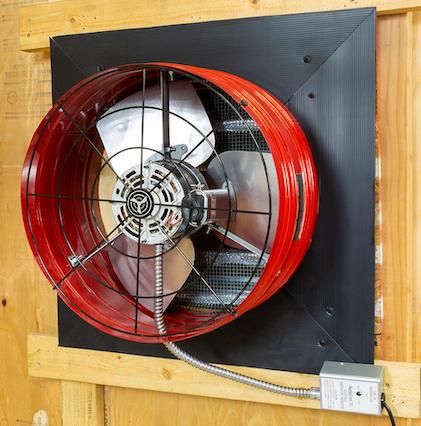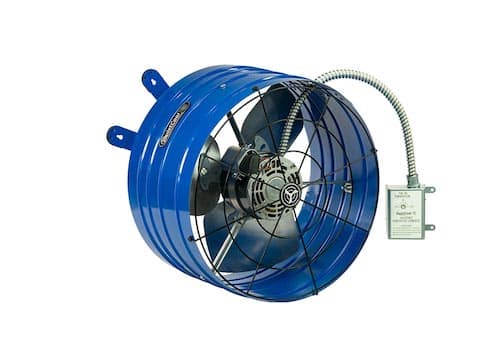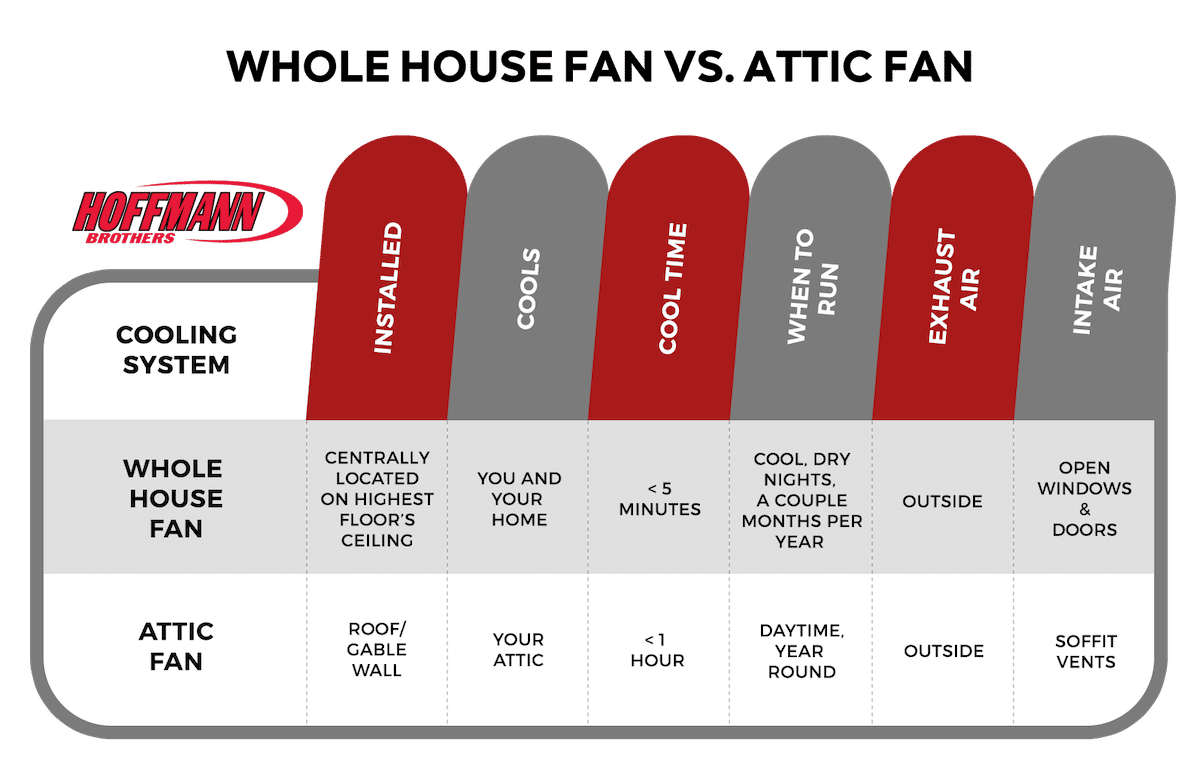Summer temperatures can bring your attic space above 160 degrees F. All that heat trapped in your attic means the rooms closest to it start to heat up too, and your air conditioning will have to work harder and longer to keep the house cool. This is where an attic fan becomes crucial. Installing attic fans in your roof or gable wall is a routine job for a professional. Having the right tools, the training, and the experience make attic fan installation a snap for our Hoffman Brothers technicians.
Attic Fan Installation Throughout the St Louis Area

Before selecting and doing an attic exhaust fan installation, you should measure and calculate that you have enough space to accommodate a properly functioning fan. At a minimum, you’ll need:
A licensed heating and cooling contractor from Hoffmann Brothers can help you make sure you have the appropriate space for an attic fan. Part of that process includes ensuring you have enough cross ventilation (already in place or to be installed along with your attic fan).
You can select an attic exhaust fan with thermostat and humidistat included, so you can monitor your attic’s humidity and temperature. This is great for those long hot, humid St. Louis summer days (and even through the winter).
What is an Attic Fan?
The purpose of attic fan installation is to help ventilate your attic space by exhausting the hot, stale air of the attic outside, while drawing in the cooler, fresh air to bring the attic temperature down.
Other Names for an Attic Fan

- Attic exhaust fan
- Attic vent fan
- Whole house attic fan (Note: an attic fan and a whole house fan are two different things. See the comparison here to learn more.)
- Attic ventilation fan
- Power attic fan
- Power Attic Ventilator (PAV)
- Electric attic fan
- Roof attic fan
Attic Fan Replacement for St Louis Homes
Attic fan not working? Contact Hoffmann Brothers to discuss your best options when needing the repair of a motor, a belt or to replace your entire attic fan system with a new unit. There are several reasons you might need an attic fan replacement.
- Electrical – Be sure to check for a blown fuse, tripped circuit breaker, or a bad connection if your fan won’t turn on.
- Thermostat – You can see if this is your issue by overriding the fan with the manual on/off switch. If the switch works, you know the attic fan thermostat is the culprit. These are often just as easy and more cost-efficient to replace than to repair, as you can see in this video.
- Motor – An attic fan motor replacement or repair is the most expensive one to make on an attic fan. Depending on the attic fan motor, you will either have to replace it alone or replace the whole system. Attic fan motors typically last 10–15 years, so keep this in mind if yours goes out. Besides age, problems with an attic fan motor include:
- A damaged or broken belt
- Debris blocking the air intake and exhaust
- The number of fan blades vs. the fan speed
- The need for maintenance or more air
For more air, try opening a window at least 30 feet away to create the required airflow for proper functioning.
Benefits of Attic Fans
According to the US Department of Energy, “Ventilation is the least expensive and most energy-efficient way to cool buildings.” Attic ventilation fans are no exception. In fact, there are a number of attic fan benefits, including:
- Lower Overall Home Temperatures – By removing the hot attic air, it lowers the temperature of the rooms closest to it by an average of 10 degrees F and consequently lowers the rest of the house’s temp too.
- Increased Energy Efficiency – Attic fans don’t use much energy to operate, which leads to the next two benefits.
- Reduced Workload and Need for Your AC – By keeping the attic temperature lower using air handlers, your AC and attic fan will not have to work so hard to cool the house.
- Lower Utility Bills – Using less energy and reducing the need for the AC means you could notice up to a 30% savings on your utility bill.
- Extended Roof Life – These fans reduce the heat and humidity in your attic, and therefore, limits mold growth, rot, and other issues that extend the life of your roof.
- Backup for Your AC – If your AC goes out on the hottest day of the year, you still have a means of keeping your house from turning into a sauna!
Whole House Fan vs. Attic Fan
You may hear these two names used interchangeably. However, it is incorrect to do so. A whole house fan and an attic fan are two different types of fans – though they serve a common goal – keeping your home cool. This Washington Post article has a great explanation of their differences, but a short and sweet description looks like this:
- Attic Fans operate year-round and serve to ventilate and reduce heat buildup in your attic only.
- Whole House Fans operate during only a couple seasons each year and function to ventilate and cool the whole house, including the attic and living spaces.
Then keep the attic fan temperature setting between 100–110 degrees F, and run it during the heat of the day year round.

Common Attic Fan FAQs
Yes, attic fans can cool a house down in less than an hour and use less energy than an air conditioner to do it.
To choose the right power attic ventilator (PAV) and for it to properly function, you must measure and calculate the proper spacing of the fan, vents, and air intake needed. Once the fan is installed and running, the attic fan exhausts the hot, humid air in your attic outside and draws in the cooler, fresh air. This effectively reduces the heat buildup and lowers the temper of your attic.
To be most effective, make sure your home is equipped with the following:
- Insulation less than R-19
- An air sealed attic floor
- Sufficient ventilation space
- Well-insulated and sealed attic HVAC equipment
Then keep the attic fan temperature setting between 100–110 degrees F, and run it during the heat of the day year round.
To get started on installing or replacing an attic fan in your St. Louis area home, give Hoffmann Brothers a call today at 314-664-3011.



